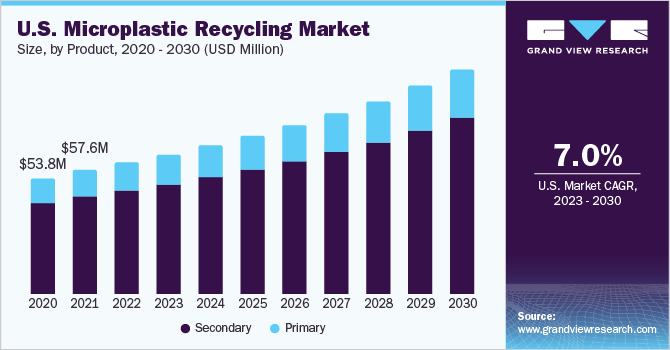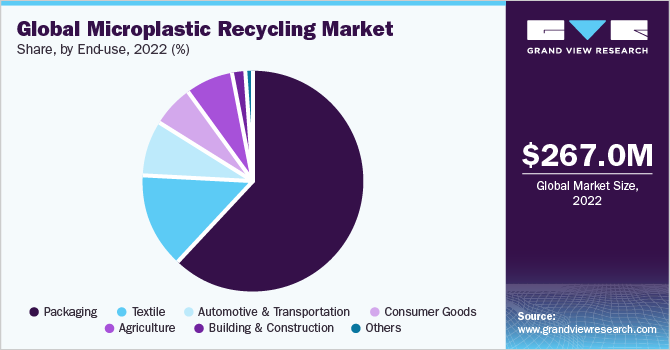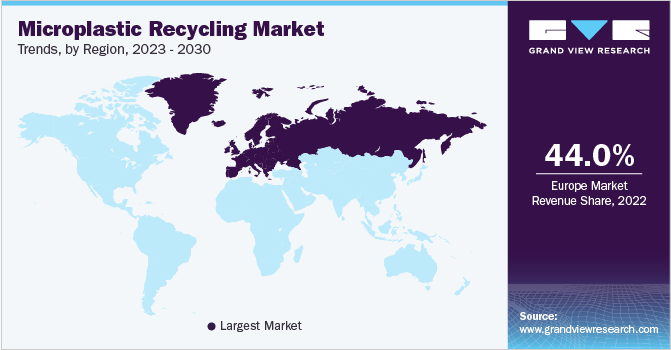- Home
- »
- Plastics, Polymers & Resins
- »
-
Microplastic Recycling Market Size & Share Report, 2030GVR Report cover
![Microplastic Recycling Market Size, Share & Trends Report]()
Microplastic Recycling Market Size, Share & Trends Analysis, By Product (Primary, Secondary), By End-use (Packaging, Agriculture, Consumer Goods, Textile, Automotive & Transportation), By Region, And Segment Forecasts, 2023 - 2030
- Report ID: GVR-4-68040-082-4
- Number of Report Pages: 120
- Format: PDF, Horizon Databook
- Historical Range: 2018 - 2021
- Forecast Period: 2023 - 2030
- Industry: Bulk Chemicals
Microplastic Recycling Market Size & Trends
The global microplastic recycling market size was valued at USD 267.0 million in 2022 and is expected to grow at a compound annual growth rate (CAGR) of 6.8% from 2023 to 2030. The market is expected to grow in the coming years owing to increasing government regulations, environmental concerns, technological advancements, consumer awareness, and the increasing use of microplastics in different industries. Significant research and development in the U.S. regarding microplastic recycling is expected to be a major market driver in the country. Manufacturers are engaged in developing new technologies and processes for the efficient and cost-effective recycling of microplastics. Manufacturers in the country have set sustainability goals which have increased demand for recycled plastics including microplastics.

Different governments across the globe are implementing regulations to reduce plastic waste, which in turn is expected to drive the demand for microplastic recycling. In addition, increasing consumer awareness regarding the environmental impact of their actions and are seeking out sustainable products and services. This has led to an increase in demand for products made from recycled materials, including microplastics.
Microplastic recycling generates revenue for businesses and reduces production costs in the recycling industry. Recycling microplastics reduces the amount of plastic waste that ends up in landfills or oceans, thereby minimizing the impact on the environment. Furthermore, increasing demand from end-use industries including automotive & transportation, packaging, consumer goods, textile, and others is creating lucrative opportunities for microplastic recycling.
Product Insights
Secondary product segment led the market and accounted for more than 76.0% share of the global revenue share in 2022. Secondary microplastic recycling refers to the process of recovering microplastics that have already been used and discarded, such as plastic bottles, packaging, and other waste. Secondary microplastic recycling can help minimize the amount of plastic waste that ends up in landfills, oceans, and other natural environments. In addition, secondary microplastic recycling can be cost-effective, as recycled materials are less expensive than virgin materials.
Microbeads are easily available from the personal care industry, which is a significant feedstock for the microplastic recycling market. Owing to technological advancements in recycling it possible to recover microbeads from waste streams and transform those into high-quality recycled materials. Also, the use of recycled microbeads can provide manufacturers with a competitive edge in meeting consumer demand for sustainable products.
End-Use Insights
Packaging end-use segment led the market and accounted for more than 62.0% share of the global revenue share in 2022. The packaging industry is shifting towards sustainable and eco-friendly packaging solutions owing to government regulations and growing consumer awareness. The use of recycled plastics, including microplastics, is seen as an effective way to reduce the environmental impact of packaging.

Similar to the packaging industry, there is a growing demand for sustainable textiles that are made from recycled materials. Recycled microplastics can be used to produce a range of textiles, including clothing, carpeting, and upholstery.
Owing to environmental concerns automotive manufacturers are focusing on reducing the weight of vehicles which will help reduce emissions and improve fuel efficiency as well. The use of recycled microplastics in lightweight materials can help achieve these goals while also promoting sustainability. Recycled microplastics can be used in the production of different interior components including seating, door panels, and dashboard panels.
Regional Insights
Europe dominated the market and accounted for more than 44.0% share of global revenue in 2022. The European Union has implemented strict regulations on the use of single-use plastics and waste management. The EU Circular Economy Package aims to promote the transition to a more sustainable and resource-efficient economy, and microplastic recycling is an important part of this. The European Union has set a target of recycling approximately 55% of plastic packaging waste by 2030, and microplastic recycling is seen as an important part of achieving this goal.

Different manufacturers in Europe are promoting microplastic recycling. For instance, Ioniqa the Dutch company is using a chemical recycling process to turn PET waste into high-quality raw materials, including microplastics.
Microplastics have become a major environmental issue in North America, owing to the growing public concerns and awareness about their impact on wildlife and human health. In North America, various government regulations are aimed at reducing plastic waste and promoting recycling. For instance, taking effect in January 2022, California passed a law requiring manufacturers to use a minimum amount of recycled plastic in their products. The plastic beverage containers must contain at least 15% recycled content.
Key Companies & Market Share Insights
Most of the key players operating in the market have integrated their raw material production and distribution operations to maintain product quality and expand their regional presence. This provides companies with a competitive advantage in the form of cost benefits, thus increasing the profit margins. Companies are undertaking research and development activities to develop new industrial plastics to sustain market competition and changing end-user requirements. Research activities focused on the development of new materials, which combine several properties, are projected to gain wide acceptance in this industry in the coming years.
For instance, in February 2023, REMEDIES project aspires to collect over 400 tons of microplastic. The project is funded by the European Union and has a valuation of approximately USD 8.8 million. Furthermore, this project aims to build a sustainable model to restrain the impact of microplastics in different Mediterranean areas, through the design of advanced systems to recycle, collect, monitor, and convert the extracted waste into new products. Some prominent players operating in the global microplastic recycling market include:
-
Carbios
-
Purecycle technologies
-
Ioniqa
-
Calyxia
-
Polygonesystems
-
PlanetCare
-
ECOFARIO
-
Ocean Diagnostics
-
Oceanworks
-
Matter.
Microplastic Recycling Market Report Scope
Report Attribute
Details
Market size value in 2023
USD 283.6 million
Revenue forecast in 2030
USD 448.5 million
Growth Rate
CAGR of 6.8% from 2023 to 2030
Base year for estimation
2022
Historical data
2018 - 2021
Forecast period
2023 - 2030
Quantitative units
Revenue in USD million & CAGR (%) from 2023 to 2030
Report coverage
Revenue forecast, competitive landscape, growth factors and trends
Segments covered
Product, end-use, region
Regional scope
North America; Europe; Asia Pacific; Central & South America; Middle East & Africa
Country Scope
U.S.; Canada; Mexico; Germany; UK; France; China; India; Japan; Brazil
Key companies profiled
Carbios; Purecycle technologies; Ioniqa; Calyxia; Polygonesystems; PlanetCare; ECOFARIO; Ocean Diagnostics; Oceanworks; Matter.
Customization scope
Free report customization (equivalent up to 8 analysts working days) with purchase. Addition or alteration to country, regional & segment scope.
Pricing and purchase options
Avail customized purchase options to meet your exact research needs. Explore purchase options
Global Microplastic Recycling Market Report Segmentation
This report forecasts revenue and volume growth at global, regional & country levels and provides an analysis of the industry trends in each of the sub-segments from 2023 to 2030. For this study, Grand View Research has segmented the global microplastic recycling market report based on product, end-use, and region:
-
Product Outlook (Revenue, USD Million, 2018 - 2030)
-
Primary
-
Secondary
-
-
End-use Outlook (Revenue, USD Million, 2018 - 2030)
-
Packaging
-
Agriculture
-
Consumer goods
-
Textile
-
Automotive & Transportation
-
Building & Construction
-
Others
-
-
Regional Outlook (Revenue, USD Million, 2018 - 2030)
-
North America
-
U.S.
-
Canada
-
Mexico
-
-
Europe
-
Germany
-
UK
-
France
-
-
Asia Pacific
-
China
-
India
-
Japan
-
-
Central & South America
-
Brazil
-
-
Middle East & Africa
-
Frequently Asked Questions About This Report
b. The global microplastic recycling market is valued to be USD 267.0 million in 2022 and is anticipated to be valued at USD 283.6 million in 2023 owing to the rising demand for microplastic recycling from end-use industries including packaging, agriculture, and others.
b. The microplastic recycling market is anticipated to grow at a CAGR of 6.8% from 2023 to 2030 to reach USD 448.5 million by 2030. owing to increasing government regulations, environmental concerns, technological advancements, and consumer awareness.
b. Secondary product across the product segmentation has a market share of above 62.0% in 2022 owing to the attributes of minimizing the amount of plastic waste that ends up in landfills, oceans, and other natural environments.
b. The key market players present across the microplastic recycling market include Carbios, Purecycle Technologies, Ioniqa, Calyxia, Polygonesystems, PlanetCare, ECOFARIO, Ocean Diagnostics, Oceanworks, and Matter
b. Key factor driving microplastic recycling market include rising plastic pollution across the oceans hampering aquatic lifestyle.
Share this report with your colleague or friend.
![gvr icn]()
NEED A CUSTOM REPORT?
We can customize every report - free of charge - including purchasing stand-alone sections or country-level reports, as well as offer affordable discounts for start-ups & universities. Contact us now
![Certified Icon]()
We are GDPR and CCPA compliant! Your transaction & personal information is safe and secure. For more details, please read our privacy policy.
We are committed towards customer satisfaction, and quality service.
"The quality of research they have done for us has been excellent."





